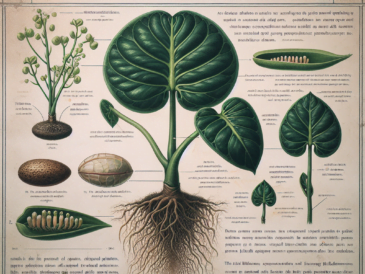History and Popularity of Philodendrons
The story of philodendrons begins in the tropical Americas, where most of these species originate. They have been part of human culture for centuries, first used by indigenous peoples before gaining fame in European botanical collections during the 17th century. Their ease of cultivation and dramatic foliage have cemented them as favorites among both novice and expert gardeners. Over time, philodendron plants have proliferated in homes and offices, cherished for their versatility and ability to thrive with minimal care, raising their profile as one of the most sought-after houseplants worldwide.
Benefits of Growing Philodendrons
Embracing philodendrons in our living spaces offers several benefits beyond their visual appeal. These plants contribute to improved air quality by filtering out harmful substances such as formaldehyde. Furthermore, their presence can enhance mental well-being, with studies indicating that interacting with houseplants can lower stress levels. The maintenance of philodendrons is straightforward, making them an ideal choice for both green-thumbed aficionados and those new to caring for plants—providing satisfaction regardless of gardening experience.
A. Differentiating Between Climbing and Non-climbing Types
The Philodendron genus offers a multitude of species, broadly categorized into two groups: the climbers and the non-climbers. The climbing varieties, known for their vigorous growth, have the tendency to cling and ascend upon available support with their aerial roots. These types are perfect for indoor trellises or moss poles. Conversely, the non-climbing Philodendrons showcase an upright form, expanding outward or upward without support structures, thereby serving as ideal ornamental centerpieces on tables or floors.
B. Key Characteristics of Popular Philodendron Varieties
When exploring popular Philodendron types, numerous characteristics stand out. The ‘Heartleaf’ Philodendron is distinguished by its heart-shaped, glossy leaves, creating a cascading effect in hanging baskets. The ‘Split Leaf’ Philodendron, scientifically known as Monstera deliciosa, features large, perforated foliage that can lend a tropical vibe to any space. The ‘Elephant Ear’ Philodendron’s name pays homage to its immense, ear-like leaves. Each of these variants brings its own unique aesthetic to plant collections.
C. Selecting the Right Philodendron for Your Space
In choosing the most suitable Philodendron for an area, several factors should be considered – including size constraints, lighting conditions, and personal taste. Smaller spaces may benefit from a compact, climbing Philodendron that can be trained vertically, whereas larger rooms could accommodate the prominence of expansive, non-climbing species. It’s essential to match the plant with the light exposure it will receive; some thrive in low-light areas while others demand more brightness. Lastly, your preferred style will inform your choice amongst the diverse range of leaf shapes and plant habits available.
Philodendron Plant Growing Essentials
Thriving in various indoor environments, Philodendron plants are adaptable and favored for their lush foliage. However, to ensure the best growth and health of these tropical natives, several basic requirements must be addressed. These include their light exposure, temperature and humidity preferences, as well as soil quality and drainage.
Light Requirements for Optimal Growth
Philodendrons prefer bright, indirect light to flourish, although they can tolerate lower light levels. Direct sunlight, especially during hot afternoons, should be avoided as it can scorch their leaves. A spot near a window that receives filtered light often serves as an ideal location. If natural light is limited, artificial grow lights can suffice to provide the necessary luminescence.
Temperature and Humidity Preferences
A warm and humid surrounding is where Philodendrons thrive best. They favor temperatures between 65-78 degrees Fahrenheit (18-25 degrees Celsius). Temperatures below 55 degrees Fahrenheit (13 degrees Celsius) can hinder their growth and cause damage. In addition to warmth, these plants enjoy a humid atmosphere; thus, placing them in naturally humid areas like bathrooms or kitchens can be beneficial. If the air is too dry, using a humidifier or misting the leaves regularly can improve the humidity levels around the plant.
Soil Composition and Drainage Needs
The right soil mix is crucial for the robust growth of Philodendron plants. An ideal blend would be one that is rich, loose, and drains well. A combination of peat, perlite, and vermiculite often provides the necessary balance between moisture retention and drainage. Ensuring proper drainage is paramount to prevent root rot; thus, planting in pots with drainage holes is recommended. Frequent checks of soil dampness can prevent waterlogged conditions that may lead to problems for your Philodendron.
In summary, catering to the specific needs of light exposure, temperature and humidity, and soil composition will create an environment where Philodendrons can prosper. Taking these guidelines into account will not only result in healthier plants but will also grace your living space with vibrant tropical beauty.
Choosing the Right Container
When selecting a container for your Philodendron, ensure it has sufficient drainage to prevent water accumulation which could be detrimental to the plant’s roots. A well-draining pot, possibly with multiple holes at the bottom, is ideal. While size matters, start with a container that’s just one size larger than the plant’s current one, as an overly large pot may hold too much moisture, leading to root rot.
Potting and Repotting Techniques
Understanding the potting process can greatly improve your Philodendron’s health. Begin by placing a layer of pebbles or broken pottery pieces at the pot’s base to enhance drainage. Combine a standard houseplant potting mix with perlite or coarse sand to boost aeration and drainage. When repotting, gently tease out the roots if they’re densely coiled. Transfer your Philodendron into the center of the new container, adding potting mix around it for stability, then water immediately to settle the soil.
Initial Planting and Care Instructions
Once you’ve planted your Philodendron in its container, position it in a spot where it will receive indirect sunlight. These tropical plants favor humid conditions, so consider misting occasionally or placing a tray with pebbles and water beneath to increase moisture levels around it. Water the soil whenever the top inch feels dry to the touch; however, avoid overwatering as Philodendrons don’t appreciate soggy soil. Commence with a modest amount of fertilizer, following the instructions specified on the product, to nourish your green companion without overwhelming it.
A. Watering Schedules and Techniques
Cultivating healthy Philodendron plants begins with understanding their hydration preferences. These tropical natives thrive in moist soil, yet excessive water can lead to root problems. A balanced watering routine is crucial where the soil is allowed to dry slightly between watering sessions. Employing a “soak and dry” technique, by providing enough water to dampen the soil thoroughly and then waiting for the top inch to become dry, promotes optimal root health. Over-watering can cause yellow leaves and root rot, whereas under-watering may result in dry, brown leaf edges.
B. Fertilization Needs and Recommendations
Nourishment is key for Philodendron’s growth and vitality. Feeding them every 4-6 weeks during the growing season (spring and summer) with a balanced, water-soluble fertilizer supports their lush foliage development. In fall and winter, it’s advisable to reduce fertilizing as plant growth naturally slows down. It’s also beneficial to dilute the fertilizer to half the recommended strength to prevent buildup of mineral salts in the soil which could potentially damage the plant roots.
C. Pruning and Training Philodendrons
Philodendrons are generally low-maintenance when it comes to pruning. The goal of pruning is to maintain desired shape and size or to remove any yellow or dead leaves to encourage new growth. While trimming, making cuts just above the leaf nodes directs new growth and keeps plants full and bushy. Support climbers with moss poles or trellises to encourage upward growth, which replicates their natural inclination towards reaching for sunlight amidst forest canopies.
D. Identifying and Managing Common Pests and Diseases
Alertness to pests and diseases is fundamental for Philodendron care. Common invaders include aphids, mealybugs, spider mites, and scale insects. The first line of defense involves removing pests by wiping the leaves with a soft, damp cloth or using a mild soap solution or insecticidal soap as necessary. For disease prevention, ensuring proper air circulation around the plants and avoiding overly damp conditions help significantly. Watch out for signs like brown spots or rotting stems which indicate serious issues that might require more targeted treatments.
Methods of Propagating Philodendrons
Propagating philodendron plants is a straightforward task that allows gardeners to create new plants from their existing philodendrons. There are primarily three methods employed for propagation: stem cuttings, air layering, and division. Each method has its own process, but stem cuttings are the most popular due to their simplicity and high success rate, especially for indoor plant enthusiasts. Air layering is slightly more complex, involving wounding part of the stem to encourage root growth while still attached to the parent plant. Division, meanwhile, involves physically separating the plant into multiple sections, each with its own root system.
Step-by-Step Guide to Propagation
The propagation process begins by selecting a healthy portion of the plant. With clean scissors or shears, cut a section of the stem about 3-6 inches long, ensuring there are at least two or three leaves present and a few nodes where roots can emerge from.
1. Prepare a container with fresh, well-draining potting mix suitable for philodendrons.
2. Dip the cut end into rooting hormone to stimulate root growth. This step is optional but can enhance success rates.
3. Plant the cutting into the soil, making sure a node is buried just beneath the surface where roots can sprout.
4. Water the soil lightly to settle it around the cutting.
The next critical step is to create an ideal environment for the cutting by covering it with plastic or placing it in a greenhouse-like setting that maintains high humidity levels. Keep the cutting in bright, indirect sunlight, and maintain consistent moisture in the soil without letting it become waterlogged.
Caring for New Philodendron Cuttings
Once you’ve successfully propagated your philodendron cuttings, they will require close attention to ensure they grow healthy and strong. It’s important to keep the soil consistently moist without overwatering, which could lead to root rot. Position the new plant in an area that gets plenty of bright, indirect sunlight, avoiding direct exposure which may scorch the tender leaves.
As the cuttings grow, be vigilant about maintaining an optimal environment, adjusting as necessary if you spot signs of distress such as yellow leaves or stunted growth. Furthermore, feed your young philodendrons with a diluted liquid fertilizer every so often to support their development until they mature and become established enough to care for like any other philodendron.
Enhancing Aesthetics Through Pruning and Shaping
Philodendron plants, revered for their luscious foliage, can become even more appealing with the correct pruning and shaping techniques. Judicious trimming not only maintains the plant’s health by removing dead or yellowing leaves, but it also encourages more vigorous growth. Trimming should be performed with clean, sharp implements to prevent infection and ensure a precise cut. Regularly snipping back can help create a denser canopy, which contributes significantly to the plant’s ornamental value. Be mindful not to over-prune as this could potentially stunt future growth.
Adjusting Care for Variegated Varieties
Variegated philodendrons require a slight alteration in care compared to their solid-green counterparts due to their unique coloration patterns. These beautiful variations come at a cost – their white or cream-colored areas contain less chlorophyll, which may slow down their growth. To compensate, ensure they receive ample indirect light and consider using a fertilizer that’s suitable for these specific types. Moreover, slightly less frequent watering might be necessary, as the lower chlorophyll levels affect the plant’s thirst.
Troubleshooting Growth Issues
When philodendron plants face growth complications, begin by scrutinizing environmental factors like light exposure, watering frequency, humidity levels, and temperature consistency. Problems often arise if the plant is stationed in harsh direct sunlight or in an overly dim locale. Adapt the watering routine to the plant’s needs, normally allowing the top inch of soil to dry out before hydrating again.
If leaves start to turn brown and crispy, it could signify a lack of moisture in the air, necessitating an increase in humidity. Assessing the plant’s living conditions is pivotal when addressing and resolving any growth hindrances.



